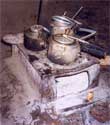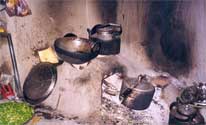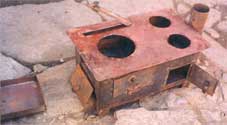Cooking Stove Improvements: Design for Remote High Altitude Areas Dolpa Region Nepal, Sjoerd Nienhuys April 2005
 |
 |
 |
 |
ABSTRACT
Metal and mud cooking stoves are analysed in Dolpa, a remote high altitude district in Nepal (over 2000m) where poor firewood efficiency of cooking stoves has been observed whilst the area is already largely deforested. Current metal or mud stoves have the air-intake above the firewood, lowering gas temperatures and causing incomplete combustion. More than 20 improvement options are presented in a table. These lead to higher burning temperatures, reduced firewood consumption and lesser soot development. Modifications have been made to lower manufacturing costs. The paper briefly explains the principles of the improvements and provides detailed sketches of the solutions. Improved cooking efficiency requires chopping of the firewood into
small pieces, but the additional time spent is balanced against the considerably less time spent in the collection of firewood. The prototype stove has been field-tested and modified several times to produce a model that is easy to manufacture and is acceptable to the villagers.
Information is based on the author’s personal experience and technical information from the stoves discussion group at www.stoves.bioenergylists.org
